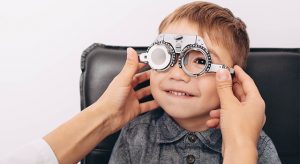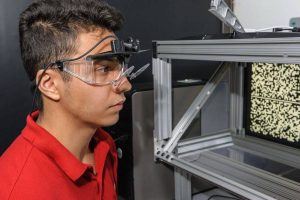Did you know? Each eye has six muscles to control eye movement and focusing.
It is comfortable and easy to accomplish visual tasks at any distance and in any direction of gaze when these eye muscles are working in perfect harmony.
The most important eye muscles control the convergence (aiming) and focusing of the eyes.
But what happens when the eye muscles are not working as a team?
What is convergence?
Convergence is the ability for the eyes to aim and point inward, such as needed for reading, computer use or doing your favorite craft.
We need this visual skill every time we do homework, study for an exam or use a computer at the office. The eyes should be in essentially parallel alignment when looking straight ahead and far away; as the object moves closer, the eyes must bend inward toward each other.
When both eyes aren’t able to work together when looking at anything close up, convergence insufficiency (CI) occurs.
CI is a binocular vision condition that affects near vision and eye muscle coordination. It makes it difficult to focus on near tasks like reading and school work. In adults, it can harm performance in the workplace.
What causes CI?
The #1 cause of convergence insufficiency is an eye muscle weakness known as exophoria.
This condition is caused when the eyes have a tendency to drift outward, meaning the eyes need to work harder to focus on a book or a computer screen.
Difficulties with convergence eventually results in the eyes becoming tired, leading to loss of attention, eye strain, headaches, even migraines.
Eye focusing
In order to keep any image clear, the eye must be able to focus clearly, just like a camera. Eye focusing is also known as accommodation.
When we are looking at something far away, our eyes focus on that object and then to look at something closer the focusing needs to change to maintain clarity.
The convergence and focusing systems work together and are linked in the brain so that when we shift our vision from far to close, they reinforce each other and keep what we are looking at single and clear.
However, when these two visual skills do not work together, the most common diagnosis made is Convergence Insufficiency (CI).
Contact an eye doctor near you, if you notice any signs below in your child.
SEE RELATED: Do I Have Convergence Insufficiency?
Convergence insufficiency signs
When either the convergence or focusing systems are not working at full capacity their teamwork is compromised, resulting in specific signs:
- Eye fatigue
- Double vision
- Headaches
- Reading reading skills
- Difficulties with attention or concentration
- Avoidance of homework
In more severe cases, when the brain is very fatigued, one eye may drift away from the target, resulting in episodes of double vision or even exotropia, a type of strabismus or eye turn.
Exotropia can involve the same eye turning outward all of the time or alternating between the two; it can also be present only part of the time or all of the time.
What else should a parent look out for?
Several more signs that parents should watch for when their child reads include:
- Excess blinking or eye watering
- Avoiding reading or other similar activities
- A tendency to turn the head when reading
- Comments regarding ‘seeing two’ of anything
- Using one hand to cover an eye when reading
- A tendency to hold reading material either too close or too far away
In addition, parents should make sure that their child has a well-lit and comfortable place to read, and that the child is maintaining proper posture.
Encourage all children to avoid reading while laying on the floor, and if they must read in bed, they should do so while sitting up. It’s also a good idea for all children to take frequent breaks to refocus and relax.
How to treat convergence insufficiency
Eyeglasses
Before starting any treatment, an eye doctor will first want to evaluate their patient’s eyes to see if there is a focusing difficulty or un uncorrected refractive error that could be causing some of the symptoms.
Wearing eyeglasses to help focusing or correct myopia (nearsighted) or hyperopia (farsighted) can sometimes minimize or even eliminate a mismatch between the convergence and accommodative systems, resulting in quick relief of eye strain symptoms.
It’s also possible that prisms should be added to the child’s eyeglass prescription.
Vision Therapy
Vision therapy (VT) exercises, which use a variety of techniques to strengthen the convergence system, are very successful in treating CI, especially for children.
The ultimate goal of VT is to improve binocular vision skills so that reading and computer use may be done without fatigue.
LEARN MORE: Vision Therapy for Children
Schedule a comprehensive eye exam with an eye doctor near you, if either you or your child don’t seem to use your eyes efficiently.
If your child is not achieving their potential at school it could be an undiagnosed visual problem.
Treatment by an eye doctor could have a profound effect on your child and might just be the solution you have been searching for.









